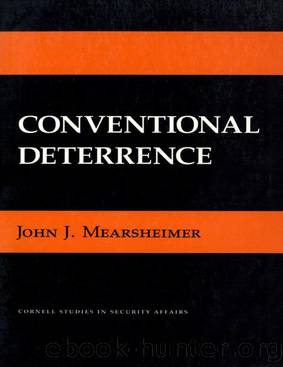Conventional Deterrence by Mearsheimer John J

Author:Mearsheimer, John J. [Mearsheimer, John J.]
Language: eng
Format: epub
Tags: Political Science, Security (National & International), History, Military, Strategy, History & Theory, International Relations, Arms Control
ISBN: 9781501713255
Google: Cd8ZDgAAQBAJ
Publisher: Cornell University Press
Published: 1985-08-21T14:27:32.532078+00:00
[6]
The Prospects for Conventional
Deterrence in Central Europe
In the previous three chapters, I have used my theory to explain past deterrence failures and successes. I shall now analyze the prospects for deterrence in Central Europe, where the armed forces of NATO and the Warsaw Pact face each other. More specifically, this chapter will seek to determine the prospects for deterring the Soviets from launching a conventional a ack in a future crisis.
Certainly the Allies do not rely exclusively on conventional forces to deter the Soviets. Soviet decision makers contemplating a conventional a ack would have to consider the possibility that the numerous tactical nuclear weapons in Europe might be used or that strategic nuclear forces might be deployed against the Soviet Union.
This chapter, however, will investigate only the prospects for conventional deterrence in Europe. Actually, with the emergence of strategic parity and the Alliesâ manifest lack of enthusiasm for tactical nuclear weapons, the importance of the conventional element in the overall deterrence equation has increased significantly within the past decade. 1
Whether or not deterrence obtains in a future crisis will depend, in large part, on whether the Soviets think that they can launch a successful blitzkrieg. Their aim will be complete and rapid destruction of NATOâs capability to wage war; this objective is reflected in the Sovietsâ military literature as well as in the organization of their ground forces.2 The Soviets have no intention of engaging in a lengthy war of a rition. 3 Nor is it likely that they would pursue a limited aims strategy. Even if the Soviets were to achieve their objectives, NATO would not be defeated and would still be capable of continuing the war. In fact, it is very likely that the conflict would turn into a war of a rition, an outcome the Soviets certainly want to avoid.
Could the Soviets effect a successful blitzkrieg against NATO? Any analysis must address two closely related issues. First, it must determine whether the Soviets have the force structure, the doctrine, and the raw ability to implement such a strategy. Second, when NATO's capabilities and the theaterâs terrain are considered, what are the prospects for Soviet success? It may very well be that the Soviet military is well primed to launch a blitzkrieg but that NATO
in turn has the capability to thwart it. 4
Any assessment of the NATO-Pact balance will depend on certain assumptions about the preparatory moves both sides would take before the war starts. Although the possibilities are many, observers most o en posit three scenarios. The first is the standing start a ack, 5
in which the Soviets launch an a ack a er hardly any mobilization and deliver a knockout blow against an unsuspecting NATO. 6 This eventuality is not, however, likely. Without significantly improving the readiness of their standing forces, the Soviets would not have the capability to score a decisive victory. Instead they would have to se le for capturing a portion of West German territory. As I have
noted, such a limited victory is hardly an a ractive option.
Download
This site does not store any files on its server. We only index and link to content provided by other sites. Please contact the content providers to delete copyright contents if any and email us, we'll remove relevant links or contents immediately.
| Arms Control | Diplomacy |
| Security | Trades & Tariffs |
| Treaties | African |
| Asian | Australian & Oceanian |
| Canadian | Caribbean & Latin American |
| European | Middle Eastern |
| Russian & Former Soviet Union |
The Secret History by Donna Tartt(16662)
The Social Justice Warrior Handbook by Lisa De Pasquale(11494)
Thirteen Reasons Why by Jay Asher(7803)
This Is How You Lose Her by Junot Diaz(5800)
Weapons of Math Destruction by Cathy O'Neil(5047)
Zero to One by Peter Thiel(4835)
The Myth of the Strong Leader by Archie Brown(4796)
Promise Me, Dad by Joe Biden(4459)
Beartown by Fredrik Backman(4435)
Stone's Rules by Roger Stone(4423)
How Democracies Die by Steven Levitsky & Daniel Ziblatt(4414)
The Fire Next Time by James Baldwin(4352)
100 Deadly Skills by Clint Emerson(4086)
A Higher Loyalty: Truth, Lies, and Leadership by James Comey(4041)
Rise and Kill First by Ronen Bergman(4021)
The David Icke Guide to the Global Conspiracy (and how to end it) by David Icke(3892)
The Farm by Tom Rob Smith(3878)
Secrecy World by Jake Bernstein(3789)
The Doomsday Machine by Daniel Ellsberg(3738)
